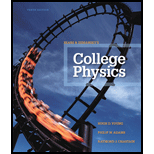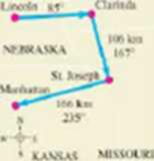Problem 1CQ: A guidebook describes the rate of climb of a mountain trail as 120 m per kilometer. How can you... Problem 2CQ: Suppose you are asked to compute the cosine of 3 meters. Is this possible? Explain your answer. Problem 3CQ: Which of the following is a reasonable height for an adult male (a) 2 cm, (b) 200 cm, or (c) 20,000... Problem 4CQ: Which of the following is a reasonable age for an adult female: (a) 6 106 s, (b) 6 108 s, or (c) 6... Problem 5CQ: Which of the following is a reasonable mass for an adult person: (a) 105 g, (b) 108 g, or (c) 1010... Problem 6CQ: Atomic quantities are now used to define the second and the meter. Could some atomic quantity he... Problem 7CQ: Suppose you ask your lab partner to look up the equation for the volume of a certain shape of radius... Problem 8CQ: (a) The mass m of an object is proportional to its volume V: m = kV. What are the SI units of K? (b)... Problem 9CQ: Based only on consistency of units, which of the following formulas could not be correct? In each... Problem 10CQ: Based only on consistency of units, which of the following formulas could not be correct? In each... Problem 11CQ: (a) In adding scalars, is 1 m + 1 n necessarily equal to 2 m? (b) In adding two vectors, each of... Problem 12CQ: Is it possible for the magnitude of a vector (a) to be smaller than the magnitude of any of its... Problem 13CQ: (a) Does it make sense to say that a vector is negative? Why? (b) Does it make sense to say that one... Problem 14CQ: The three vectors A, B, and C are shown in Figure 1.22. All three vectors have the same magnitude,... Problem 1MCP: A world-class term s player can serve a tennis ball at 150 mi/h (about 75 m/s). The length of a... Problem 2MCP: Suppose that bacon is sold for 2 per pound. If you were to buy 1 kilogram of bacon, what would you... Problem 3MCP: A vector is directed at an angle above the +x axis, pointing into the first quadrant. If the x... Problem 4MCP: A mass of 1.0 103 kg is the same as A. 1012 g. B. 106 g. C. 1 kg. D. 1 mg. Problem 5MCP: If the vector B has a magnitude of 25 m and makes an angle of 30 with the +x axis, the vector B A.... Problem 6MCP: If vector A has components Ax and Ay and makes an angle with the +x axis, then A. A = Ax + Ay... Problem 7MCP: If the distance d (in meters) traveled by an object in time t (in seconds) is given by the formula d... Problem 8MCP: The speed of a sound wave traveling in a medium that has bulk modulus B and mass density (mass... Problem 9MCP: If vector A has unity magnitude and makes an angle of 45 with the +x axis, then the x and y... Problem 10MCP: If vector A has components Ax = 3 and Ay = 4, then the magnitude of A is A. 7. B. 7. C. 7 D. 5. E.... Problem 1P: (a) How many ohms are there in a 7.85 megohm resistor? (b) Typical laboratory capacitors are found 5... Problem 2P: (a) The recommended daily allowance (RDA) of the trace metal magnesium is 410 mg/day for males.... Problem 3P: (a) Starting with the definition 1.00 ln. = 2.54 cm, find the number of kilometers in 1.00 mile. (b)... Problem 4P: (a) The density (mass divided by volume) of water is 1.00 g/cm3. What is this value in kilograms per... Problem 5P: Calculate the earths speed in its orbit around the sun in m/s, km/h, and mi/h, using information... Problem 6P: How many nanoseconds does it take light to travel 1.00 ft in vacuum? (This result is a useful... Problem 7P: Gasoline mileage. You are considering buying a European car and want to see if its advertised fuel... Problem 8P: While driving in an exotic foreign land, you see a speed-limit sign on a highway that reads 180.000... Problem 9P: Filler up! you fill up your gas tank in Europe when the euro is worth 1.25 and gasoline coste 1.35... Problem 10P: Bacteria. Bacteria vary somewhat In size, but a diameter of 2.0 m is not unusual. What would be the... Problem 11P: Compute the number of seconds in (a) an hour, (b) a 24 hour day. and (c) a 365 day year. Problem 12P: Some commonly occurring quantities. All of the quantities that follow will occur frequently in your... Problem 13P: Express each of the following numbers to three, five, and eight significant figures: (a) = 3... Problem 14P: Express each of the following approximations of to six significant figures: (a) 22/7, (b) 355/113.... Problem 15P: Blood is thicker than water. The density (mass divided by volume) of pure water is 1.00 g/cm3, that... Problem 16P: White dwarfs and neutron stars. Recall that density is mass divided by volume and consult Chapter 0... Problem 17P: Atoms and nuclei. The atom helium (He) consists of two protons, two neutrons, and two electrons.... Problem 18P: The density of aluminum is 2.7 g/cm3. What Is the mass of a cube of aluminum that is 5.656 cm on a... Problem 19P: Cell walls. Although these quantities vary from one type of cell to another a cell can be 2.0 pm in... Problem 20P: A brass washer has an outside diameter of 4.50 cm with a hole of diameter 1 25 cm and is 1 50 mm... Problem 21P: Estimate the total mass of all the humans presently living on earth. Problem 22P: A stack of printer paper is 2 inches thick and contains 500 sheets Estimate the thickness of an... Problem 23P: How many cells in the body? Although their sizes vary, cells can be modeled as spheres 2.0 m in... Problem 24P: How many times does a typical person blink her eyes in a lifetime? Problem 25P: You are using water to dilute small amounts of chemicals in the laboratory drop by drop. How many... Problem 26P: How many dollar bills would you have to stack to reach the moon? Would that be a cheaper way to get... Problem 27P: Space station. You are designing a space station and want to get some idea how large it should be to... Problem 28P: A beating heart. How many times does a human heart beat during a lifetime? How many gallons of blood... Problem 29P: How long would it take you to walk to the moon, end how many steps would you have to take, assuming... Problem 30P: Estimate the value of your weight in gold. What would be the volume of that amount of geld in cubic... Problem 31P: On a single diagram, carefully sketch each force vector to scale and identify its magnitude and... Problem 32P: Hearing rattles from a snake, you make two rapid displacements of magnitude 1.8 m and 2.4 m. In... Problem 33P: A ladybug starts at the center of a 12-in .-diameter turntable and crawls in a straight radial line... Problem 34P: For the vectors A and B shown in Figure 1.24, carefully sketch (a) the vector sum A+B; (b) the... Problem 35P: Consider the force vectors A and B shown in Figure 1.25. Each has a magnitude of 5 N. Sketch in a... Problem 36P: A rocket fires two engines simultaneously. One produces a thrust of 725 N directly forward, while... Problem 37P: In each of the cases that follow, the magnitude of a vector is given along with the counterclockwise... Problem 38P: In each of the cases that follow, the components of a vector A are given. Find the magnitude of that... Problem 39P: A woman takes her dog Rover for a walk on a leash. To get the little dog moving forward, she pulls... Problem 40P: If a vector A has the following components, use trigonometry to find its magnitude and the... Problem 41P: Compute the x and y components of the vectors A,B,and C shown in Figure 1.26. Problem 42P: Vector A has components Ax = 1 30 cm, Ay = 2.25 cm: vector B has components Bx = 4.10 cm. By = 3 75... Problem 43P: A plane leaves Seattle, flies 85 mi at 22 north of east and then changes direction to 48 south of... Problem 44P: Vector A has a magnitude of 20 m arc makes an angle of 30 above the positive x axis. Vector B has a... Problem 45P: Three horizontal ropes are attached to a boulder and produce the pulls shown In Figure 1.27. (a)... Problem 46P: A disoriented physics professor drives 3.25 km north, then 4.75 km west, end then 1 5 km south. (a)... Problem 47P: A postal employee drives a delivery truck along the route shown in Figure 1.28. Use componants to... Problem 48GP: Baseball mass. Basebal rules specify that a regulation ball shell weigh no less than 5.00 ounces and... Problem 49GP: Velocity vector A has components Ax = 3 m/s and Ay = 4 m/s. A second velocity vector B has a... Problem 50GP: How much blood In a heartbeat? A Typical human contains 5.0 L of blood, and it takes 10 min for all... Problem 51GP: Muscle attachment. When muscles attach to cones, they usually do so by a series of tendons as shown... Problem 52GP: A woman starts from her house and begins jogging down her street. In order to keep a record of her... Problem 53GP: While surveying a cave, a spelunker follows a passage 180 m straight west, then 210 m in a direction... Problem 54GP: A sailor in a small sailboat encounters shifting winds She sails 2.00 km east men 3.50 km southeast... Problem 55GP: Dislocated shoulder. A patient with a dislocated shoulder is put into a traction apparatus as shown... Problem 56GP: On a training flight, a student pilot flies from Lincoln Nebraska, to Clarinda, Iowa: then to St... Problem 57PP: Calculating Lung Volume in Humans. In human lungs, oxygen and carbon dioxide are exchanged in the... Problem 58PP: Assuming that alveoli are spherical, what is the diameter of a typical alveolus? A. 0.20 mm B. 2 mm... Problem 59PP: Individuals vary considerably in total lung volume. Figure 1.33 shows the results of measuring the... format_list_bulleted



 University Physics Volume 1PhysicsISBN:9781938168277Author:William Moebs, Samuel J. Ling, Jeff SannyPublisher:OpenStax - Rice University
University Physics Volume 1PhysicsISBN:9781938168277Author:William Moebs, Samuel J. Ling, Jeff SannyPublisher:OpenStax - Rice University Principles of Physics: A Calculus-Based TextPhysicsISBN:9781133104261Author:Raymond A. Serway, John W. JewettPublisher:Cengage Learning
Principles of Physics: A Calculus-Based TextPhysicsISBN:9781133104261Author:Raymond A. Serway, John W. JewettPublisher:Cengage Learning Glencoe Physics: Principles and Problems, Student...PhysicsISBN:9780078807213Author:Paul W. ZitzewitzPublisher:Glencoe/McGraw-Hill
Glencoe Physics: Principles and Problems, Student...PhysicsISBN:9780078807213Author:Paul W. ZitzewitzPublisher:Glencoe/McGraw-Hill College PhysicsPhysicsISBN:9781305952300Author:Raymond A. Serway, Chris VuillePublisher:Cengage Learning
College PhysicsPhysicsISBN:9781305952300Author:Raymond A. Serway, Chris VuillePublisher:Cengage Learning Physics for Scientists and Engineers: Foundations...PhysicsISBN:9781133939146Author:Katz, Debora M.Publisher:Cengage Learning
Physics for Scientists and Engineers: Foundations...PhysicsISBN:9781133939146Author:Katz, Debora M.Publisher:Cengage Learning An Introduction to Physical SciencePhysicsISBN:9781305079137Author:James Shipman, Jerry D. Wilson, Charles A. Higgins, Omar TorresPublisher:Cengage Learning
An Introduction to Physical SciencePhysicsISBN:9781305079137Author:James Shipman, Jerry D. Wilson, Charles A. Higgins, Omar TorresPublisher:Cengage Learning




